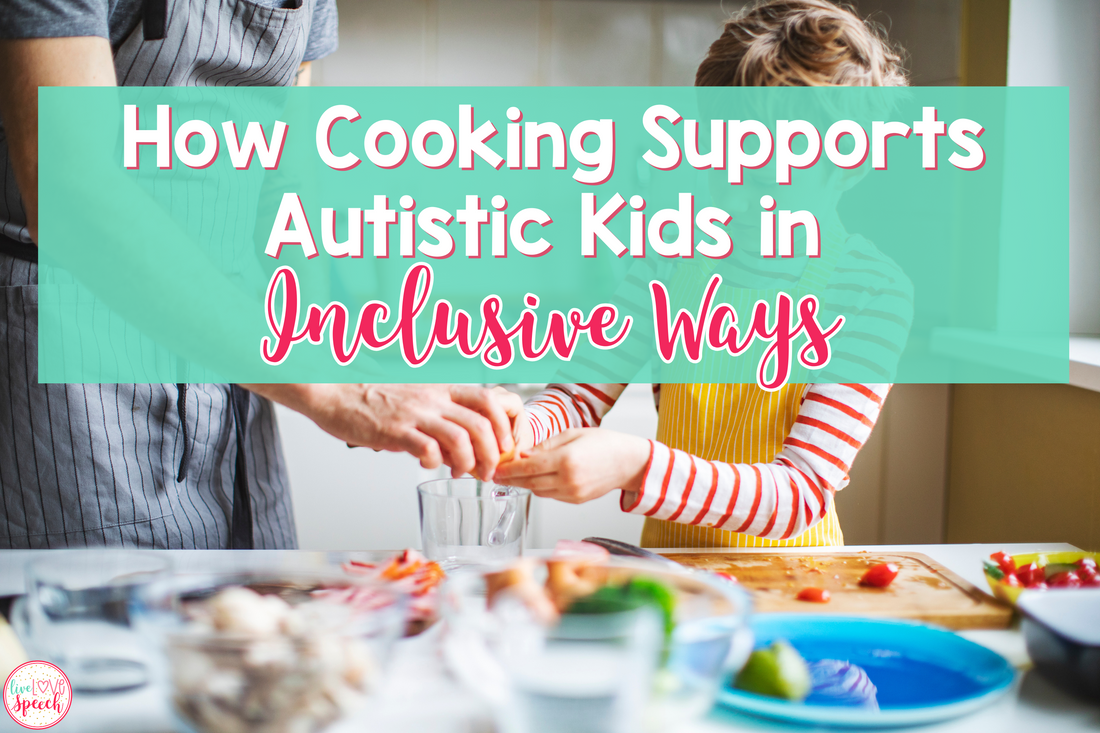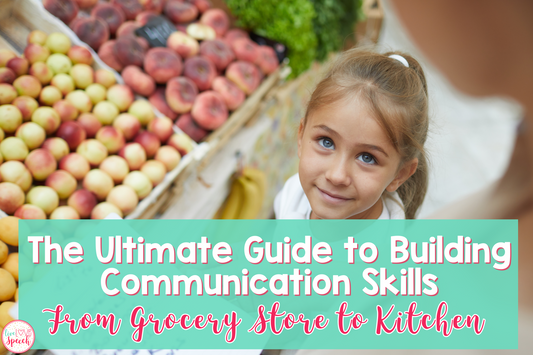 At our place, the kitchen is where everything happens: snacks, messes, laughs, and learning all rolled into one. Over the years, I have seen how powerful cooking activities can be, especially when we approach them in inclusive ways that meet each child where they are.
At our place, the kitchen is where everything happens: snacks, messes, laughs, and learning all rolled into one. Over the years, I have seen how powerful cooking activities can be, especially when we approach them in inclusive ways that meet each child where they are.
Whether you are a parent, teacher, or SLP, cooking is a hands-on way to build real-life skills, support communication, and create meaningful moments with kids. The best part is you can keep it simple and still make a big impact.
Here's why I keep coming back to cooking as one of my favorite tools for supporting autistic children in inclusive ways.
1. Predictable Structure and Routine
Oftentimes, autistic children feel more comfortable when they know what to expect. Cooking offers a clear beginning, middle, and end.
-
Visual recipes and step-by-step charts make it easier to follow along. I especially love using these Visual Recipe Cards for Kids. They are picture-based, easy to use, and perfect for building confidence with each step.
-
Doing the same recipe multiple times helps kids feel more confident each time.
-
Routines like washing hands, gathering materials, and checking off steps give kids a sense of control and structure.
This predictable flow makes it easier for kids to join in and feel successful in inclusive ways.
2. Sensory-Friendly Experiences
Cooking naturally includes lots of sensory input, but you can adjust it based on what each child prefers.
- Some kids love touching ingredients, while others might prefer using tools or watching from the side.
- Try using soothing scents like vanilla or cinnamon and offer options like gloves if certain textures are too much.
A sensory-friendly visual recipe like Beach Pudding Cups from the July Visual Recipes Set is a great way to keep the activity engaging without overwhelming sensitive learners. The textures are smooth and familiar, the colors are fun and inviting, and the steps are broken down in a way that feels manageable.
Plus, the summer theme adds a playful twist that makes kids excited to participate. It’s a gentle and structured way to introduce sensory exploration in an inclusive and low-pressure environment.
When you have visuals to guide the process and flexibility in how kids participate, cooking becomes fun and manageable in inclusive ways.
3. Strength-Based Learning
Cooking lets you build on what kids already do well.
-
Many children with autism excel in areas such as routines, details, and following instructions. All skills used in cooking.
-
You can build independence by giving them their own job, like gathering ingredients, mixing, or setting the table.
-
There is also room for creativity. Let kids decorate cookies, build a fruit kabob, or pick their toppings.
All of this helps autistic kids feel capable and confident while learning in inclusive ways.
4. Promotes Communication Skills
Cooking gives kids a reason to talk and be heard.
-
Teach words like pour, mix, hot, and done while you cook.
-
Encourage kids to make choices, ask for items, or describe what they are doing.
-
For kids using AAC, cooking is full of natural ways to practice using devices with words like “more,” “help,” and “I want spoon.”
It turns language into something fun and meaningful in inclusive ways.
5. Builds Social Interaction
Cooking together creates natural chances to practice social skills.
-
Taking turns is easy when kids add ingredients or share tools.
-
They can talk about what they are making, their favorite foods, or smells they notice.
-
Even in small groups, cooking encourages cooperation and teamwork in inclusive ways that feel relaxed and fun.
6. Visual and Hands-On Learning
Cooking is made for visual learners and kids who learn best by doing.
- Use visual recipes like these kid-friendly, step-by-step recipe cards to give clear, concrete support at every stage.
Let kids get involved with mixing, pouring, and scooping; it keeps them engaged and focused.
When something does not go as planned, that is a learning moment. “Oops, the milk spilled. What should we do?”
Hands-on learning like this helps autistic kids stay connected in inclusive ways.
7. Builds Executive Functioning Skills
Cooking supports planning, organizing, and flexible thinking, all while making something delicious.
-
Let kids help gather ingredients and tools. That builds planning and organization skills.
-
If you run out of something, ask, “What else could we use?” This encourages problem-solving.
-
Use timers to show when food is ready or how long to wait. This helps build time awareness.
These small moments help kids grow in big ways in inclusive ways.
8. Encourages Independence and Choice
Cooking is full of ways for kids to take ownership and make decisions.
-
Let kids pick the recipe, decide on toppings, or choose their role for the day.
-
Give responsibilities like setting the table or helping with cleanup.
-
Celebrate even the small wins like pouring cereal or making toast. These build confidence over time.
Supporting independence in inclusive ways helps kids feel proud of themselves.
Why Autism Cooking Activities Matter
Cooking is a way to connect, teach, and build confidence. When we adapt cooking activities in inclusive ways, we create a space where every child feels seen and supported.
You do not need fancy ingredients or Pinterest-perfect recipes. You just need the willingness to meet kids where they are and help them grow, one stir, scoop, or sprinkle at a time.

Looking for more support? Be sure to check out this helpful post with practical strategies and tips for cooking with autistic children. It is full of real-life ideas that make cooking easier and more meaningful for every learner.
SAVE THIS POST FOR LATER
Don't forget to save this post on Pinterest so you'll be all set when you're ready to start cooking!!








